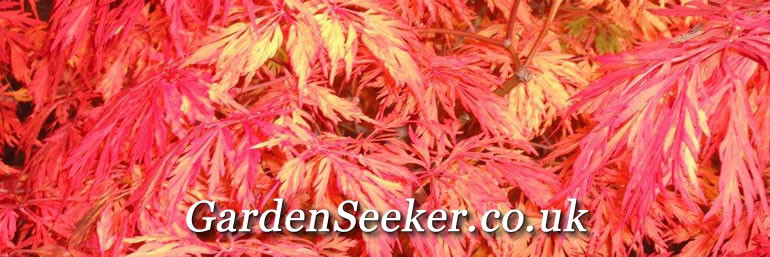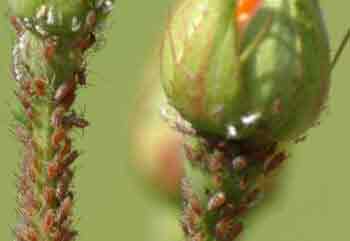
Greenfly
When talking about garden and plant problems, it is important to firstly identify the source of the problem - whether plant pest, disease, deficiency or other matters such as problems with garden soils.
Positive identification of the garden problem is not always straightforward, for some symptoms - especially as shown up in the foliage - can be the result of either a pest, a disease, a nutritional deficiency or simply an environmental matter - such as planting in the wrong soil; lack of water or light; a draught or even localised pollution problem.
It is important to identify the actual cause of the problem and not be misguided by the effect. Such an instance is Tree Lichen which is seen as the problem, whereas it is the effect of a problem with its tree host!
General garden problems can be caused poor cultivation; human error; environmental damage; climatic changes or severe weather conditions; animal damage; pests on plants; pests in the soil; diseases in plants; diseases in the soil; general soil problems and wrong plant selection.
(That little list should make you realise that the correct identification of the problem in the garden is not easy! However, a methodical approach to isolating the problem by good recognition of the symptoms will help! The important thing to realize about garden problems, is that the correct identification of the symptoms will start you on the path to rectifying the problem, and also helping you understand the steps you can take to prevent most of them. Many problems are first noticed with some form of leaf damage. Unfortunately, many of the leaf symptoms are very similar in appearance.)
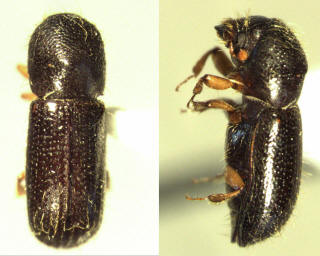
The Bark Beetle
Within the pest listing range, you will find some of the most common insect pest that affect many garden plants, including of course, the wide range of Aphids and other sap sucking insects.
Correct identification of your garden pest is very important before you start treating. Far better of course, to be aware of the pests that are prevalent in given seasons in order to use preventative methods before an infestation.
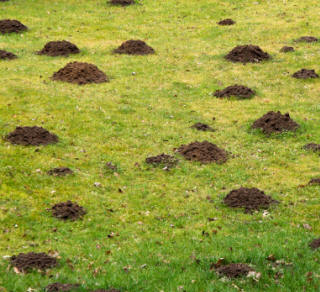
Moles in the Gardens
Mealybugs and Red Spider mites top the list of garden enemies, and also for the indoor plants - house and greenhouse. Some of the fruit enemies are in this A - S listing - especially for Strawberries and Raspberries.
In the ornamental garden, the Rhododendrons find a few enemies on this page, or should we say that the enemies find the Rhododendrons?

Vine Weevil Beetle
T - Z with garden pests will include one of the most difficult pests to get under control - Whitefly! Together with that, the larvae of the Vine weevil Beetle will play havoc with your plant's root system - often resulting in death with smaller plants. Observation of your plants on a regular basis may well alert you to what is happening underground - especially with the tell-tale leaf damage which is the hall mark of Vine Weevil Beetles.
Plant pests are normally things with legs - or at least move, whilst plant problems can either be a fungal disease, environmental or physical problem.
Diseases such as Fungi, do not move (visibly) whilst live insects do - even if only a few mm per hour as sometimes seems the case!
Plant Disease problems - which are not 'pests' - are sometimes a little difficult to recognise - but don't worry, we are here to help. Plant diseases include Blackspot on Roses but not Black fly, for that is a pest.
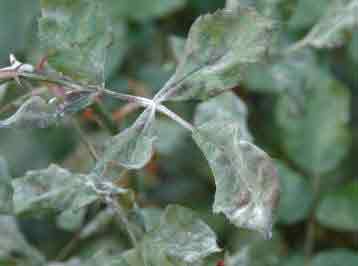
Mildew
The mildew that normally affects roses, is a form of powdery mildew. There is also a more serious - but rarer for of mildew (Downy Mildew) which this article is not concerned with. The white powdery mildew mould start off on the leaves and soon spreads to buds and other young rose shoots.
The affected foliage curls up and eventually falls off if not treated. Flower buds may not open properly, and if they do, will be severely affected. As distinct from Blackspot, Rose mildew is prevalent in dry hot conditions - in particular when the root area is dry and lacking moisture.
Problem control is not always as bad as it seems. Just get to it early, and that will help. Better still, prevent the problems happening.
There are many many more pests, diseases and general problems in many gardens. That's what makes gardening interesting. As with many things in general life, prevention is normally better than cure. But prevention is rarely thought about until the problem hits us! Where we feel there is a tried and tested method of 'prevention', we will give you the information that we are aware of, and we continue with research, trial and error to find these preventative methods.
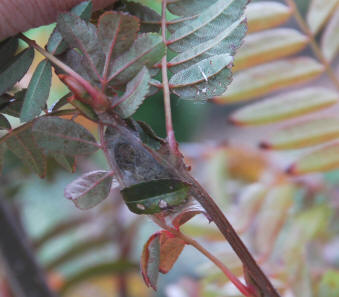
Sorbus with shot hole damage to leaves
If we can do a little bit towards prevention of problems - and that's all it usually needs (along with the knowledge of course) then it will make our gardening a lot more pleasurable. If you have any ideas of good preventative methods of cultivation, we are always pleased to hear them and pass them on to the rest of our visitors.
As can be seen in the image of the Sorbus, the problem does not always present itself on the surface, but tends to hide away! And let's face it, there are many hiding places for all manner of baddies in the average garden. So, we need to look for the signs of problems and deal with them as soon as possible, in order to prevent it spreading from the local source that is usually the case.
Most pests and diseases are dealt with with easy to use, and safe chemicals. Don't forget, that even 'organic' solutions are not always environmentally friendly! Use chemical in a responsible manner and you can be happy with your local environment. READ the labels, and if you do not understand, then drop us a mail and ask us. We will do all we can to help and reassure you.

Ladybirds
The most visual of all garden problems - after obvious animal damage - are plant pests. Plant pests are distinct from Plant Diseases in that they are actually living 'creatures'. Normally - but not always - having legs or wings to help them move round.
Aphids - Greenfly and Black fly etc - are the most common visible garden pests. Anyone with a garden would have encountered an aphid on some plant or other. Roses are suckers for greenfly (excuse the pun) and Nasturtiums make a good feast for blackfly aphids - as do the young growth of broad beans in the vegetable plot!
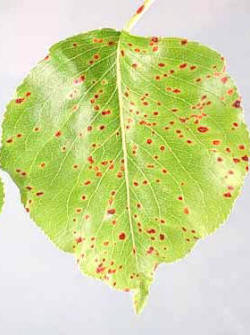
Pear Rust Infection
Diseases of Plants - Including Fungal, Bacterial and Virus Diseases.
Plant diseases are much more difficult to deal with than plant pests. Normally a plant disease has settled in with the plant before the effects are seen. This makes plant disease more difficult to treat, and in many cases the disease cannot actually be cured - simply controlled.
Plant diseases are not insects, though they can sometimes be caused and spread by insect activity.
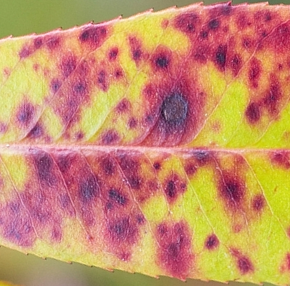
leaf spot
Plant Leaf Problems - Pest, Disease, Nutrition or Soil Problems?
The leaves of a plant are usually the first indicators that there is a problem somewhere with the plant. Often, what you see on the leaf is not the real problem, but simply shows up as an indicator that all is not well somewhere in the plant.
In terms of water provision and nutrients, the leaf is usually at the furthest point away from the source - the roots. But many problems at the roots of the plant will tend to show up firstly in the foliage of the plant.
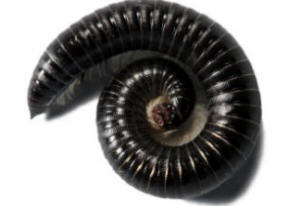
Wire Worm
Plant Root Problems - Pests and Diseases
In this section, we distinguish between soil problems and root problems. It is not always easy to decide what causing the problem, for root pests and diseases live in the soil for most or all of their life. Soil problems are normally nutrient imbalance or physical aspects of the soil makeup, such as heavy clay soils.
The difference has to be properly recognised for there is little to be gained by treating a root pest or disease problem with fertiliser!
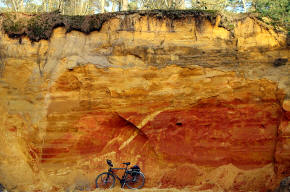
Soil/bedrock cross section
Problems with garden soils are normally the least visible – until they affect the growing plant. Soil problems in the garden can be associated with lawn problems (often) and general visible sickness symptoms on plants which are not otherwise associated with pests or diseases. Waterlogged soil is perhaps the most noticeable of soil problems.
There are many types of garden soil, and each of them have their own set of physical problems, such as light soils prone to drying out and heavy soils becoming waterlogged. Light and heavy are not the only soil types; there are many variations between.
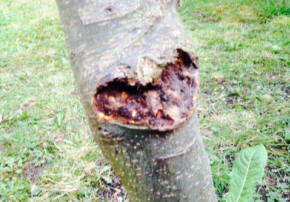
Bark Problem
Problems on bark or inside plant stems can be caused by plant pests, plant diseases, malnutrition, physical aspects, frost damage, sun damage and many other things.
Plant stems are a good line of transport for garden pests that want to travel from leaf to leaf. Often the stem is simply used as a means of getting from point A to B. But there are a number of problems - generally associated with pests or diseases - that can cause problems directly to the plant stem. On the pest side, slugs are quite happy to chomp away at the more tender stems, whilst some fungal diseases cause problems with plant stems also. Blackleg fungus is one such disease which affects plant stems.
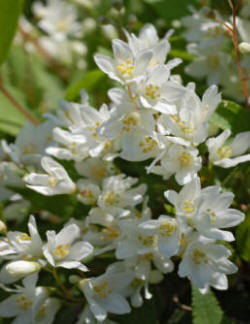
Nikko
Many gardeners are disappointed after buying a shrub in full flower at their local garden centre, then after planting, they find that the flowers drop, or as is normal, the shrub fails to flower the following year - Maybe for 3 years after planting.
The main reason why shrubs don't flower after planting in a new home, is simply that of establishment. Most container grown shrubs and perennials are normally grown in a pot that restricts their root growth. This is turn, prevents the plant from making too much foliage and stem growth, which has the effect of forcing it into flower. Flowering plants sell better at garden centres that those that simply have a label!
